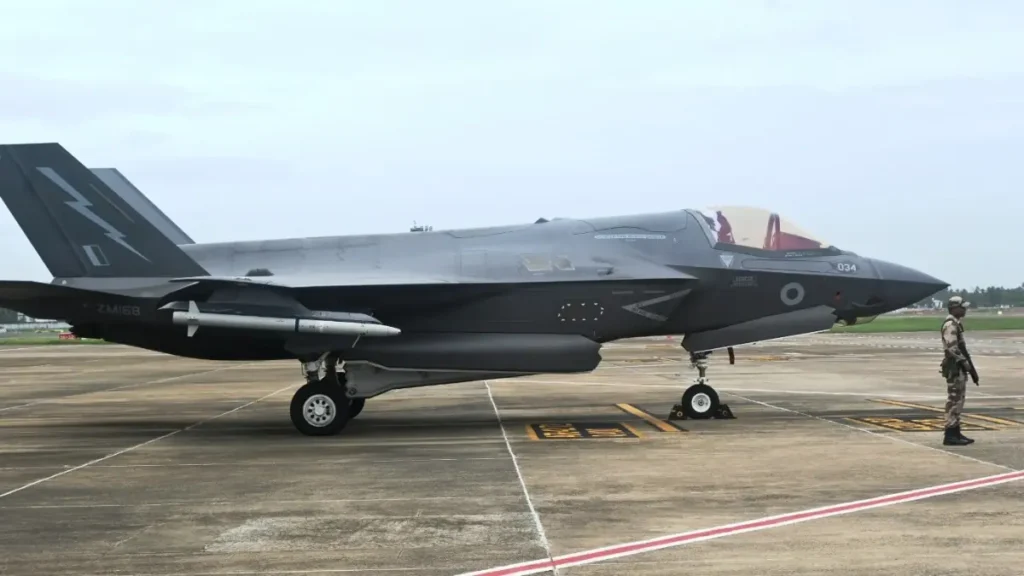On June 14, 2025, a British Royal Navy F-35B Lightning II, manufactured by Lockheed Martin, made an emergency landing in Thiruvananthapuram International Airport, Kerala, India. This fifth-generation stealth fighter jet has a purchase price exceeding $110 million. The F-35B was part of the HMS Prince of Wales Carrier Strike Group, which was conducting joint maritime exercises with the Indian Navy in the Indian Ocean about 100 nautical miles off the Kerala Coast at the time.
The emergency landing was caused by bad weather and low fuel so the jet could not return to the aircraft carrier. Initially, it was believed that low fuels caused the error and it was anticipated that if it refueled it could take off. After landing, it detected the aircraft had a malfunction in its hydraulic system which was critical for flight control and retracting the landing gear. The aircraft was subsequently deemed inoperable. Several attempts to repair the jet form a small team of British technicians were unsuccessful due to the complex nature of the problem and the jet has sat for over 20 days.
Why Dismantling the F-35B Fighter Jet
The technical challenges being faced by the F-35B, namely the hydraulic failure, have been assessed by a team of engineers from the UK and using equipment as advanced as was available up until the time of the incident, nevertheless they are irreparable on-site. The F-35B has advanced stealth technology using radar absorbing materials and encrypted software that can only be repaired using Lockheed Martin trained engineers. Also, nothing can be logged without careful logging for repairs, which is required to protect classified technology.
In its present state, it is not practical to transport it back to the UK without dismantlement as it cannot fit into a support transport aircraft C-17 Globemaster. The F-35B is around 35-feet with a wingspan and 51-feet long. It must be dismantled to allow airlifts.
After disassembly, the parts of the F-35B will be loaded onto a C-17 Globemaster, a cargo aircraft capable of large volumes of freight. Generally, the C-17 is often used for this type of work because of its size. The disassembled parts will be appropriately packed in likely, special crates to protect the jets coating and sensitive electronics while in transit to the UK for complete repairs. A 40-member team from UK aviation engineers will be responding to the disassembly and packaging but will be on-site on July 5th, 2025.
What Makes this an Embarrassment for Western Nations?
This event has charged the global stage for several reasons:
A Technical Failure of a High-Profile Asset: The F-35 “program”, which has cost over $1.7 trillion over its lifetime; will be the most expensive weapons system ever developed. Among those costs is a big operational loss of a high-profile aircraft that needs to be taken apart in a country that is not a member of NATO (India – who does not fly the F-35). A significant operational loss suggests that the jet is not reliable.
Security Breach: The F-35 stealth capabilities and encrypted nature of the systems onboard the aircraft are highly sensitive. The aircraft was on full display at a civilian airport for an extended period of time; even exposed at one point when the UK turned down Air India’s offer for the aircraft to be in a hangar, before later accepting it. Other nations could have exposed themselves to western technology to have access to aircraft, which prompted western nations to technically prevent Indian technicians and engineers from any access out of distrust, even after the cooperation.
Social media and Public Reaction: The incident achieved meme popularity, attracting attention for clever marketing from Kerala Tourism’s post on X (July 2, 2025), and it garnered various netizens engage in making Aadhar card edits, jokes, and commenting about the jet “finding peace, a toddy, and banana chips” in Kerala. Such reactions reflect India’s ability to convert a challenging situation into playful banter on social media—even though some commentators expressed concern over some diplomatic damage.
Conclusion
The event where the F-35B was grounded in Kerala is an unusual and complicated aviation incident, which sheds light on both the technological sophistication and vulnerabilities of the newest and most advanced fighter jet in the world. That fact that it had to be dismantled and airlifted back to the UK speaks to the seriousness of a hydraulic failure and the logistical challenges of handling a high-value asset in a foreign country, as well as the embarrassing reality both technically and diplomatically for Western countries such as the US and UK. It also demonstrates the cooperative spirit of India and Kerala’s ability to and find light in a unique situation as always. The dismantlement, as carried out by a special team, will ensure the jet’s return intact. But it may go down as an interesting footnote in the operational story of the F-35.

